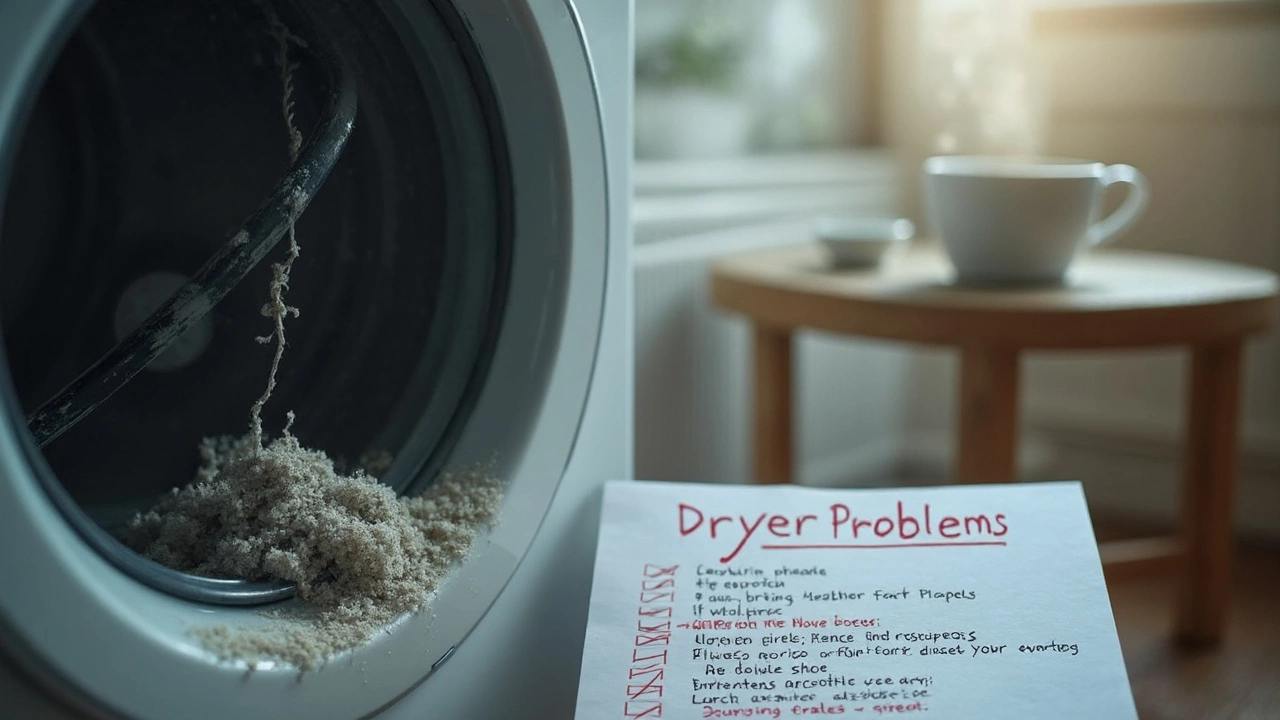Spending money on dryer repairs isn’t always smart. Ever looked at your noisy, stubborn dryer and wondered if another repair is just throwing cash away? You’re not alone. Repairs can stack up fast and sometimes the numbers just don’t make sense.
The average repair bill for a tumble dryer sits between $100 and $400. But if your dryer is already a decade old, or you’re calling the repair guy more times than your best friend, it might be time to rethink. Sometimes, the smarter move is skipping another fix and simply replacing the whole thing.
If your dryer smells like burning or shows signs of overheating, don’t second-guess it. Fire hazards are real—dryers cause thousands of house fires every year, with lint buildup and bad wiring leading the blame. Safety issues are a red line: if repair won’t fix that risk for good, it’s time for a new dryer.
- The True Cost of Dryer Repairs
- Age and Mileage: When Old is Too Old
- Frequent Breakdowns: The Last Straw
- Dangerous Faults You Shouldn’t Ignore
- Tips Before Throwing in the Towel
The True Cost of Dryer Repairs
Let’s break down what really happens to your wallet when you keep fixing a tumble dryer. The repair cost isn’t just about the money you hand over, either—you’ve got to weigh time, hassle, and the risk of throwing good cash after bad.
The average tumble dryer repair in the U.S. sits around $150 to $250, and if the heating element is shot, you’re easily looking at $230 to $400. Now, here’s the kicker: a brand-new basic dryer often starts under $500. If you’ve already paid for one repair this year, think hard about adding another.
Common replacement parts also add up fast, and not all fixes have equal value. Here’s a quick look at typical costs for parts and labor:
| Part | Average Repair Cost (USD) |
|---|---|
| Heating Element | $150 - $300 |
| Thermal Fuse | $80 - $130 |
| Drive Belt | $100 - $170 |
| Timer | $100 - $260 |
| Electronic Control Board | $200 - $400 |
If your machine needs more than one replacement, costs climb even faster. Ever seen a bill that’s half the price of a new dryer? Repairing older units rarely makes sense at that point, especially for big items like the dryer repair of the control board or drum.
Don’t forget about hidden costs: time off work for service calls, days without clean laundry, and the mental load of another repair. The numbers say it all: if a single repair runs over 50% of what a new dryer costs, it might be smarter to shop for a replacement. You’ll save stress and probably wind up with a model that’s more energy-efficient—which can cut down future utility bills, too.
Bottom line? Before handing over your credit card, compare the cost of fixing your old machine to the price of something new. Sometimes, letting go pays off big in the long run.
Age and Mileage: When Old is Too Old
Here’s a tough truth: most dryers aren’t built to last forever. The typical lifespan of a tumble dryer is about 10 to 13 years if you use it like most people. Once you start pushing past that, things get dicey. Parts wear out. Motors slow down. Sensors stop doing their job—not exactly a recipe for clean, dry laundry.
Manufacturers often stop making replacement parts after about a decade. So, if your dryer is over ten years old and something essential breaks, you’ll end up hunting far and wide for used or “compatible” parts—and even then, those fixes might only band-aid the problem for a few more cycles. At a certain point, sinking money into an old machine just doesn’t add up.
Wondering when to call it quits? Here are clear signs your dryer’s age is working against you:
- It takes forever to dry a normal load—and it’s not the lint filter’s fault.
- You hear grinding or screeching noises, even after repairs.
- Strange hot smells or the machine getting hotter than usual out of nowhere.
- Buttons don’t respond, or the tech panel randomly glitches.
- Energy bills are creeping up each month for no obvious reason.
These red flags usually mean core components (like heating elements or sensors) are aging out. Trying to stretch an old dryer can rack up energy bills or lead to bigger repair costs, especially since dryer repair shops can’t always track down the right parts anymore. If your machine is well past its prime, it’s usually smarter—money-wise and stress-wise—to invest in a newer model.

Frequent Breakdowns: The Last Straw
Replacing a broken belt is one thing, but if your dryer needs fixing every couple of months, it’s a sign you’ve got a bigger issue. Think about it—if your dryer is regularly stopping mid-cycle, refusing to heat, or making weird noises, that’s your cue. Most dryers are built to last about 10 years, tops, so if yours is nearing that birthday and keeps breaking, the headaches (and bills) aren’t stopping soon.
Here’s the breakdown: if you’re shelling out more than half the cost of a new dryer on repairs in a year, that money’s better spent on an upgrade. And if repairs start coming up for different problems—like the drum one month and the thermostat the next—it usually means the whole system is wearing out, not just one part.
According to appliance pros, repeated failures often signal the end of a dryer's useful life. Not only will you be annoyed by constant service calls, but these short-term fixes often don’t hold up. You could end up with surprise breakdowns right when you need it most.
So, if your dryer repair bills keep piling up, or you keep missing family game night because you’re waiting for a repair tech, it’s time to weigh your options. Make a quick tally of your recent repair costs. If it’s hitting $300 or more in less than a year, look at replacement models. Today’s dryers are way more efficient and use less energy, which means lower utility bills right off the bat.
Bottom line: A pattern of frequent malfunctions means your dryer’s on its last legs. Save your money and patience for something better—like a brand-new, reliable machine.
Dangerous Faults You Shouldn’t Ignore
There are a few dryer problems you just can’t afford to brush off. Fire and safety risks aren’t worth messing around with—these faults demand your attention and should make you rethink repairing your old machine.
Here’s what you shouldn’t ignore:
- Burning Smell: If your dryer smells like something is burning, stop using it. Lint can build up inside the drum or vent hose and catch fire. According to the U.S. Fire Administration, dryers cause about 2,900 home fires every year. Most of these start with lint buildup.
- Sparking or Electrical Shorts: If you see sparks, flickering lights, or hear popping sounds from your dryer, it could mean faulty wiring or a dying heating element. That’s more than just a nuisance—it can set your house on fire.
- Scorched or Melted Plug/Outlet: If the plug looks burnt or the wall outlet feels hot, you’ve got serious trouble. This isn’t a quick DIY fix; call an electrician or get rid of the dryer.
- Banging, Grinding, or Metal-on-Metal Noises: If your dryer suddenly gets louder and sounds like it’s chewing metal, bearings might be shot, or something major is misaligned. Left unchecked, you can start a fire or fry the motor.
Check out this table for a quick breakdown of common dangerous faults, what causes them, and the action you should take:
| Fault | Likely Cause | Recommended Action |
|---|---|---|
| Burning smell | Lint buildup, overheating | Stop use, clean vents, consider replacement |
| Sparks/electrical short | Wiring problem, failed heating element | Unplug, call electrician, probably replace |
| Hot/melted plug or outlet | Electrical overload or damaged circuits | Stop use, call professional, do NOT DIY |
| Grinding, loud noises | Broken bearings or drum support | Inspect, may require replacement if severe |
Trying to fix these kinds of faults on an old or failing machine rarely works out. You could throw money at the problem and still end up with a fire risk on your hands. If you find any of these signs, it’s safer to replace the dryer. Peace of mind beats a risky, patched-up machine every time.
When in doubt, remember your dryer repair budget—if a repair calls for major electrical work or if your appliance is getting up there in age, just don’t risk it. Safety first.

Tips Before Throwing in the Towel
Before you give up on your stubborn dryer, there are a few smart moves you can make to save money and avoid a rush decision. Start by making a quick checklist. Sometimes a simple fix, like clearing out lint or resetting a breaker, can get the drum spinning again. Don’t assume the worst until you try the basics.
Here’s what you should check:
- Is the lint trap and vent clean? Blocked airflow can make dryers overheat or stop working. Cleaning these takes minutes and can save you a service call.
- Check for any visible damage on the power cord or plug. If you see burn marks or exposed wires, unplug the machine and don’t try to use it.
- Listen for new sounds. A thumping or squealing noise may just mean a worn belt or bad roller, both of which can be much cheaper to replace than buying a new dryer.
- Look up the model number. Knowing if parts are still made for your dryer saves time. Some brands, like Whirlpool or LG, support parts longer than others.
Let’s look at how these checks compare with professional repair and replacement:
| DIY Basic Check | Cost | Time | Success Rate |
|---|---|---|---|
| Clean lint trap & vent | $0 | 5 min | 15% |
| Reset breaker | $0 | 2 min | 5% |
| Replace belt or roller | $10-$40 | 30-60 min | 20% |
| Professional repair | $120-$350 | 1-2 hours | Varies |
| Replace dryer | $600-$1200 | Varies | 100% |
If your unit still isn’t working after basic checks, compare costs. If the dryer repair bill is more than half the price of a new machine, most experts say it’s just not worth it. Dryer warranties typically last 1-2 years, but the average dryer lifespan is around 10-13 years. If yours is pushing past that, repairs may only buy you a little time.
Still not sure? Ask for a quote and diagnostic from a pro first. Some companies apply that fee toward repairs if you go ahead, so you’re not losing money if you do need a fix. Just remember—saving a couple hundred bucks is never worth risking your safety.
